 Materials Sciences and Applications, 2015, 6, 995-1007 Published Online November 2015 in SciRes. http://www.scirp.org/journal/msa http://dx.doi.org/10.4236/msa.2015.611099 How to cite this paper: Das, L.R., Mollah, M.Z.I., Islam, J.M.M., Akhter, S., Ahmed, F. and Khan, M.A. (2015) Fabrication of Cellulose Based Reinforced Linear Low Density Polyethylene with Polyethylene Terephthalate Composite: Effect of Acacia catechu as Coupling Agent. Materials Sciences and Applications, 6, 995-1007. http://dx.doi.org/10.4236/msa.2015.611099 Fabrication of Cellulose Based Reinforced Linear Low Density Polyethylene with Polyethylene Terephthalate Composite: Effect of Acacia catechu as Coupling Agent Lily R. Das1,2, Mohammad Zahirul I. Mollah1, Jahid M. M. Islam1, Shireen Akhter3, Farid Ahmed2, Mubarak Ahmad Khan1* 1Institute of Radiation and Polymer Technology, Atomic Energy Research Establishment, Bangladesh Atomic Energy Commission, Dhaka, Bangladesh 2Department of Physics, Jahangirnagar University, Savar, Bangladesh 3Material Science Division, Atomic Energy Centre, Bangladesh Atomic Energy Commission, Dhaka, Bangladesh Received 15 August 2015; accepted 15 November 2015; published 18 November 2015 Copyright © 2015 by authors and Scientific Research Publishing Inc. This work is licensed under the Creative Commons Attribution International License (CC BY). http://creativecommons.org/licenses/by/4.0/ Abstract Biodegradable reinforced composites are playing a vital role in the variety of application for their outstanding performance. Linear Low Density Polyethylene (LLDPE) and Polyethylene Tere- phthalate (PET) blends were prepared by twin screw extruder in different composition. The mechanical properties in 10% PET with LLDPE blend showed the best results where as tensile strength (TS) 9 MPa and percentage elongation at break (%Eb) 33. Cellulose based reinforced PET + LLDPE composite were prepared by compression molding with the optimized jute content 62% that revealed the highest mechanical properties. Cellulose based composites treated with Acacia catechu (AC) solutions (0.1% - 5% w/v) at different soaking time (2 - 20 min.) where ob- served significant improvement of the mechanical properties. Cellulose treated with 0.1% AC for 2 minutes soaking time depicted the highest mechanical properties and TS is 115% higher than untreated. Composite prepared with 0.1% AC treated showed the best mechanical properties as tensile strength (TS), bending strength (BS), tensile modulus (TM) and bending modulus (BM) were to be 47 MPa, 39 MPa, 1220 MPa and 1784 MPa respectively. The properties of TS, BS, TM and BM were improved as 9%, 30%, 14% and 34% respectively, which were better to untreated composite. Electrical properties such as dielectric constant and loss of the treated and untreated composites were found to be higher dielectric constant of treated jute composite than that of untreated samples. Water uptake and soil degradation of untreated and treated composites  L. R. Das et al. performed in significant study. The effect of AC with cellulose composites has found in remark- able changes in the mechanical properties. Keywords Jute, Cellulose, Composite, Acacia catechu, Properties 1. Introduction Fiber reinforced plastic composites played a dominant role for a long time in a variety of applications, due to their high specific strength and modulus while there has been an increasing interest in biodegradable composites reinforced with natural fibers [1] [2]. Natural fibers are usually made of cellulose, hemicelluloses, lignin and pectin with a small quantit y of water soluble materials. However, the one of primar y disadvanta ge is poor inter- facial adhesion and dispersion in olefinic thermoplastic matrix materials due to hydrophilic character of cellu- lose [3] [4]. Natural fibers such as jute, hemp, sisal, pine apple, abaca and coir have been studied as reinforce- ment and filler in composites. Among all the natural fibers, jute appears to be the most useful, economical and exhibits moderately higher mechanical properties. As a natural fiber jute fiber has been traditionally used for making twines, ropes, cords, as packaging material in sack and gunny bags, as carpet-backing and more recently as a geo-textile material. Jute is a commercially available fiber, which is cultivated almost exclusively in Ban- glade s h and I nd ia . I t ha s high c el lulo se co ntent a nd l o w micro -fibril an gle which are the desirable p rope rties of a fiber to be used as reinforcement in a polymer matrix [5] [6]. I n sp it e of t hes e ab o ve-ment io ned a d van ta ge s, j ute fiber like o ther natural fibe rs e xerts so me difficu lties while u sed as r einfor ce ment in non-p ola r po lymer matrices. Being polar and hydrophilic in nature, jute fiber exhibits poor interfacial adhesion with hydrophobic polymer matrices. To overcome these kinds of bottlenecks, many attempts, such as physical and chemical treatments, lead to changes in the surface structure and surface energy of the fibers. Khoir extract is derived from heartwood of Acacia catechu (Family: Mimosaceae) tree. Acacia catechu is highl y valuab le for i ts power ful astri ngent a nd antioxidant activities. The chief constituents of th e red heartw ood are catechin and catechu tannic acid along with small proportion of brown coloring matter. It also contains tannin, flavotanni n, gallotan nin, phloratannin etc. The catechin is a biologically important polyphenolic compound. Its heart wood extract was used in dyeing, leather tanning and preservative for fishing nets and as a viscosity regu- lator for o il drilling [7]. Polyethylene terephthalate (PET) and Linear Low Density Polyethylene (LLDPE) were used as a matrix material in this study because they have some excellent characters for composite fabrication. PET a low cost and high performance thermoplastic is widely used as packaging materials, fiber and sheet due to good rigidity, hardness, abrasion resistance, solvent resistance and electric insulation [8] [9]. The majority of the world’s PE T production is for s ynthetic fibers (60%) with bottle production accounting for 30% of demand. In th is exper iment, PET granules were blended with LLDPE at different ratios such as (10:90 and 25:75) using Twine Screw E xtruder machine . Higher perce ntage of LLDPE was ta ken to ha ve a hybr id po lymer film having relatively lo wer melti ng point ( LLDPE is 120˚C and PET is about 260˚C) which will pr event jute fabric to b urn during co mposite fabrica tion. LLDP E is one of the most imp ortant polyole fins that has be en extensivel y studied fro m both t he ind ustry and aca demic points of view, for its goo d processability, great r ecyclability and prefera- ble compatibility with other polyolefins [10] [11]. The investigation ha s made an effort to modify hessian cloth (ce llulose) with Acacia catechu to see the effect of AC on the mechanical and dielectric properties of hessian cloth-reinforced PET + LLDPE composites. The research also involves in determining the degradation characteristics and water uptake of the composite. 2. Experimental 2.1. Materials Bleached jute fabrics were collected from Bangladesh Jute Research Ins tit ut e ( B J RI ), Dh a ka, B an gla d esh. Kho ir (Acacia catechu) was collected from local market. PET (Polyethylene Terephthalate) and LLDPE (Linear Low Density Polyethylene) granule were purchased from MITSUIPET Company, Thailand and Uniplast Com. Saudi Ara b .  L. R. Das et al. 2.2. Methods 2.2.1. Preparation of Polymer Shee t Two types of Hybrid polymer sheet (10% and 25% PET in LLDPE) was prepared using a Twin Screw Extruder machine (Type-LTE 16-Lab Tech Engineering Company LTD.) by mixing PET and LLDPE granules. 2.2.2. Surface Pre-Treatment Hessian cloths were cut into small pieces (14 × 20 cm2) and dried in an oven at 100˚C for about 1 hour to re- move moisture. A number of formulations of AC (0.1% - 5%) were prepared in distilled water. Jute fabrics were soaked with these solutions for different time periods (2 - 20 min). Then the jute fabrics were dried again in an oven at 100˚C for 3-hour and kept in des iccators. 2.2.3. Fourier Transform Infrared (FTIR) FT-IR spectroscopy of the untreated and treated jute fabrics were recorded with a Happ-Ganzel spectrophoto- meter using the KBr pellet tec hnique with a resolution of 4 cm−1. 2.2.4. Thermogravimetric Analysis (TGA) TGA analysis of untreated and treated fibers was done using a thermal gravimetric analyzer (TGA-Universal Mode: V4.5A TA) at heating rate 10˚C/min under a constant flow rate (60 ml/min) of nitrogen. 2.2.5. Fabrication of Composit e Composites were prepared by sandwiching pre-weighted four layers of jute fabrics between five layers of pre- weighted polymer sheets and pressed at 199˚C for 20 min between two steel plates under a pressure of 5 tons. The composite was cooled in another press machine, then cut into the desired size using b and saw and packaged in a polyethylene bag and then kept in the desiccators prior to further te s t ing. 2.2.6. Mechanical Te sts The tensile test of the composites were determined using a Universal testing machine (model H 50 KS-0404, Hounsfield Series S, UK) gauge length of 20 mm and crosshead speed of 10 mm/min. The test was carried out according to DIN 53455 standard method. The bending strength of the composite samples was measured in the same machine with a span length of 40 mm and cross-head speed of 4 mm/min followed by ASTM D 790 stan- dard method. 2.2.7. Electrical Properties Measurement Electrical properties of the composite were carried out by using Wayne Keer Inductance analyzer (3255B) . The rectangular shaped samples were polished well to remove any roughness and the two surfaces of each sample were coated with silver paste as contact material for electrical measurement. The dielectric properties, especially the dielectric constant and dielectric loss of both the treated and untreated composites were calculated from the measured capacitance of samples using the relation ε = ct/ε0A, where C is the capacitance of the sample in va- cuum and ε0 = Permittivity of air (8.85 × 10−12), A = Area of cross-section of the sample, t = Thickness of the sample. 2.2.8. Water Uptake Test of the Composi te Untreated and treated composite samples were immersed in the beaker containing static water bath at room temperature for different time periods (up to 70 mins). Weight o f the sample s were determi ned initially then af- ter certain periods of time samples were taken out from the beaker and wiped with tissue papers then took weight again. The weight gained that is, water uptake of the samples was determined by the subtraction from fi- nal weight to initial weight. 2.2.9. Soil Degradation Study The composite samples were buried in soil for degradation study. Soil was maintained at ~25% moisture in weight and samples were buried at a depth of 25 cm. The buried samples were dug out after some time intervals (5 - 30 days) and washed in distilled water, dried in a vacuum oven at 100˚C until the samples reached a con- 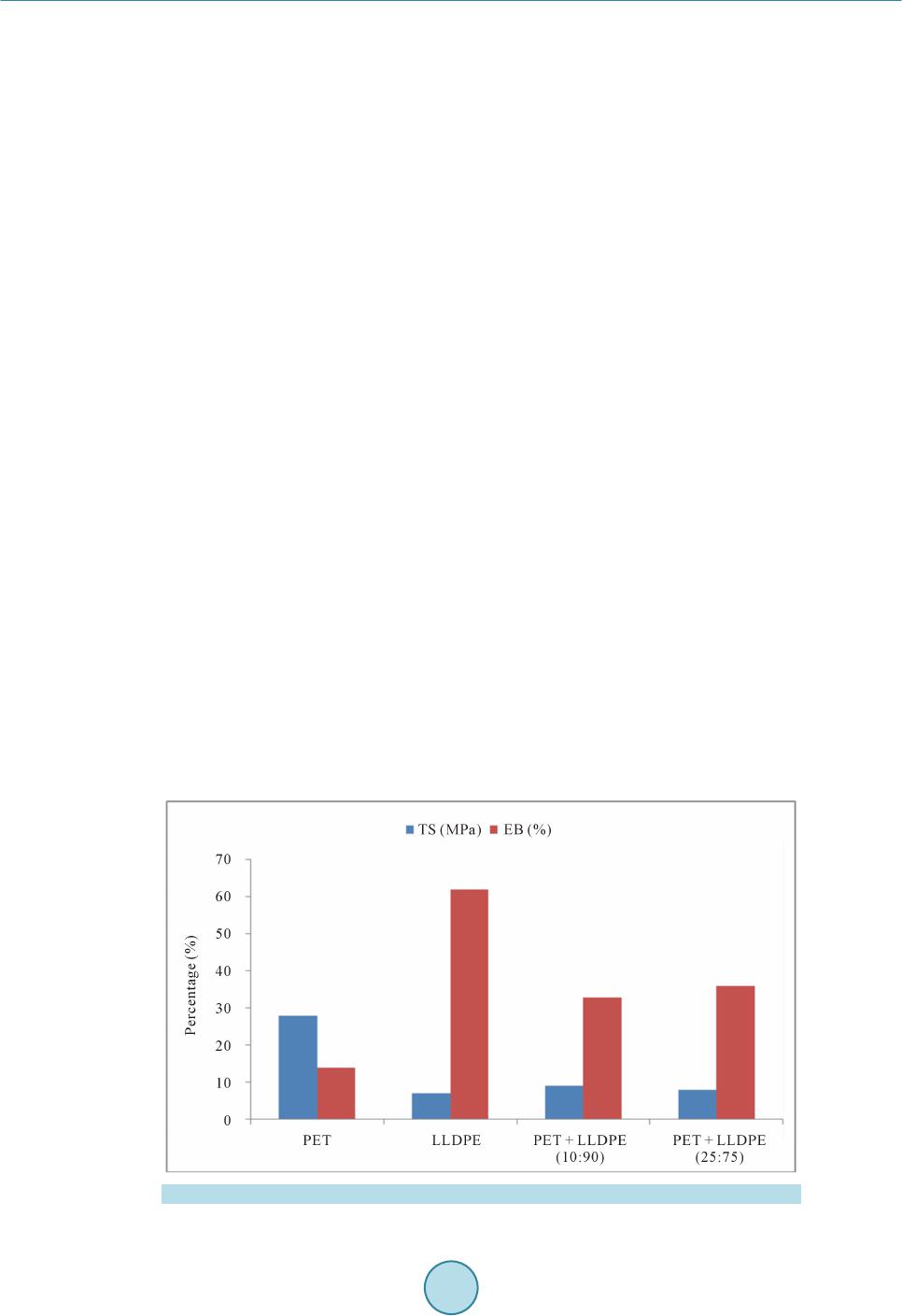 L. R. Das et al. stant weight and kept at room temperature for at least 24 h. T he mechanical properties of the samples were then measured. 3. Result and Discussion 3.1. Effect of PET/LLDPE Blend on the Mechanical Propert ie s For mechanical properties i mprovement higher percentage of LLDPE was taken to have a hybrid polymer film having relatively lower melting point which will prevent jute fabric to burn during composite fabrication. The composition of PET: LLDPE ra tio was taken as ( 10:90) and (25:75) respectively. From the mechanical st ud ie d it was obtained the tensile strength of pure PET (28 Mpa) is higher than LLDPE (7 MPa). In the composite of 10% PET with LLDPE (90%) showed higher TS (9 MPa) that of PET (25%) with LLDPE (75%) where TS is (8 MPa) because at this percentages P ET and LLDP E mix pr operl y in the b lend. T he EB% was found in highe st in pure LLDPE. The TS is increased and the EB % is decreased accordingly (Figure 1). 3.2. FT-IR Analysis The FTIR spectra of jute fabric in Figure 2(a) showed a long and broad peak at 3406.29 cm-1 indicate the pres- ence of H-bonded OH groups. A medium band observed at 2902.87 cm−1 indicates the presence of C-H stret- ching i n the fabr ics. A very short peak observed at 2 129.41 cm−1 indicates the presence of bond stret- ching vibration. A small peak observed at 1730.16 cm−1 indicates the presence of C=O stretching of unsaturated aldehyde or ketones. Very small two peaks observed at 1629.85 cm−1 and 1597.06 cm−1 indicates the presence of -C=C-stretching and N-H bending respectively. Very short peak observed 1502.55 cm−1 provides the presence of C-C stretching in ring. Another some peaks observed at 1458.16, 1425.40, 1373.32, 1321.24, 1232.51, 1159.22 and 1111.00 cm−1 attributed to the presence of C-H bending, rocking, N-O symmetric stretching, C-N st retching, C-O stretching in the fabrics [ 12]. A small and narrow peak observ ed at 896.90 c m−1 indicates C-H loop aromatics in the r i ng. T he FTIR sp ec tr a o f Acacia catechu treate d jute in Figure 2(b) sho wed almost similar type of peaks with little bit changes f or coupling between ce llulose based com posite wi th AC (0.10%) wi thin the s ame region of the fr equencie s of jute fabric such a s at 3421.72, 290 0.94, 2 1 2 9.4 1 , 173 5 .9 3 , 162 9 .8 5 , 1 5 97 . 06, 1 5 06. 4 1, 1 458.18, 1425.4, 1375.25, 1321.24, 1226.73, 1155.36, 1111, 1078.21, 1066.64 cm−1 etc. The comparative coupling FTIR spectra of composites showed in Figure 2(c). 3.3. TGA Analysis of Fibers Thermal gravimetric analysis (TGA) was used to measure the weight loss of fibers as a function of rising temperature. The weight loss in fibers occurs due to the decomposition of cellulose, hemicelluloses and lignin Figure 1 . Effe ct of PET + LLDPE blend on the mechanical properties.  L. R. Das et al. (a) (b) (c) Figure 2 . (a) FT-IR of untreated jute fabric; (b) F T-IR of AC treated jute fabr ic; (c) Comparative peak study of treated and untreated composite with 0.1% AC.  L. R. Das et al. constituents duri ng heatin g. H igher decomposition temp erature give s greater ther mal stabi lit y [13]. F r om Figure 3 it can be observed that, there are three stages of weight loss occurred as temperature increased. The first stage of weight loss was observed between 25˚C - 173˚C, which was correspondence to the release of moisture con- tent by the fiber. The second stage of weight loss occurred within the temperature between 200˚C - 345˚C, which was related to the degradation of lignin and hemicelluloses. The last stage of weight loss occurred be- tween the temperature of 345˚C - 500˚C, indicated the degra d atio n of cellulo se and other cellulosic matters fro m the fiber [14]. It also observed that, untreated fiber degrade faster than the treated fibers in the second stage of fiber degrad ation pro cess. From the results, it can be stated that hemicellulose s and lignin co nstituents were p ar- tially removed from the treated fibers which en hance thermal stability. 3.4. Effect of Jute Content on the Mechanical Properties of the Composite Effect of jute content on the mechanical properties of jute composite was measured and the results are presented in Figure 4(a) and Figure 4(b). The TS and BS of the composites were found to increase on increasing the per- centage of jute content in the composite. The highest TS and the BS at 62% jute content were found to be 43 MPa and 23MPa respectively. The TM and BM of the composite also followed the same way like TS and BS and the effect of fiber content on elongation at break (% Eb) of the composite is shown in Figure 4(a). The highest TM and BM of the composites (62%) were found to be1050 MPa and 1170 MPa respectively [Figure 4(b)]. At high levels of fiber content, poo r wetability of matr ix and improper o rientation of fiber is found in the matrix material. This may cause decrease in the mechanical properties of the composite above 62% jute. So it is clear that 62% jute content composite showed the best mechanical properties and this was considered as the optimized content of jute. The influence of jute content on mechanical properties of composites may be explained by the homogeneity of fiber in composite and wet ability of the matrix. Owing to the lower level of the fiber in the matrix, non-homogeneity of the fiber is observed in the composite material. As a result, proper load transfer is not possible by the composites. Fibe r matri x adhesio n is the ke y to a stro ng interface. O ptimum adhesion between fiber and matrix can be achieved by maximizing wetting tension. Wetting tension can be maximized by maximizing the physical interactions at the molecular level between matrix and fiber and sponta- neous wetti ng of the fiber surface with liquid matrix in order to maximize the flo w density at the inte rface [15]. 3.5. Effect of AC on Jute Fabric and Composite Hessian cloths were soaked in the AC solution for different concentrations (0.1% to 5.0%) with different soak- ing time (2 - 20 min.). The results of TS of jute fabrics with respect to different AC concentrations against Figure 3 . TGA analysis of untreated and AC treated jute fabric. 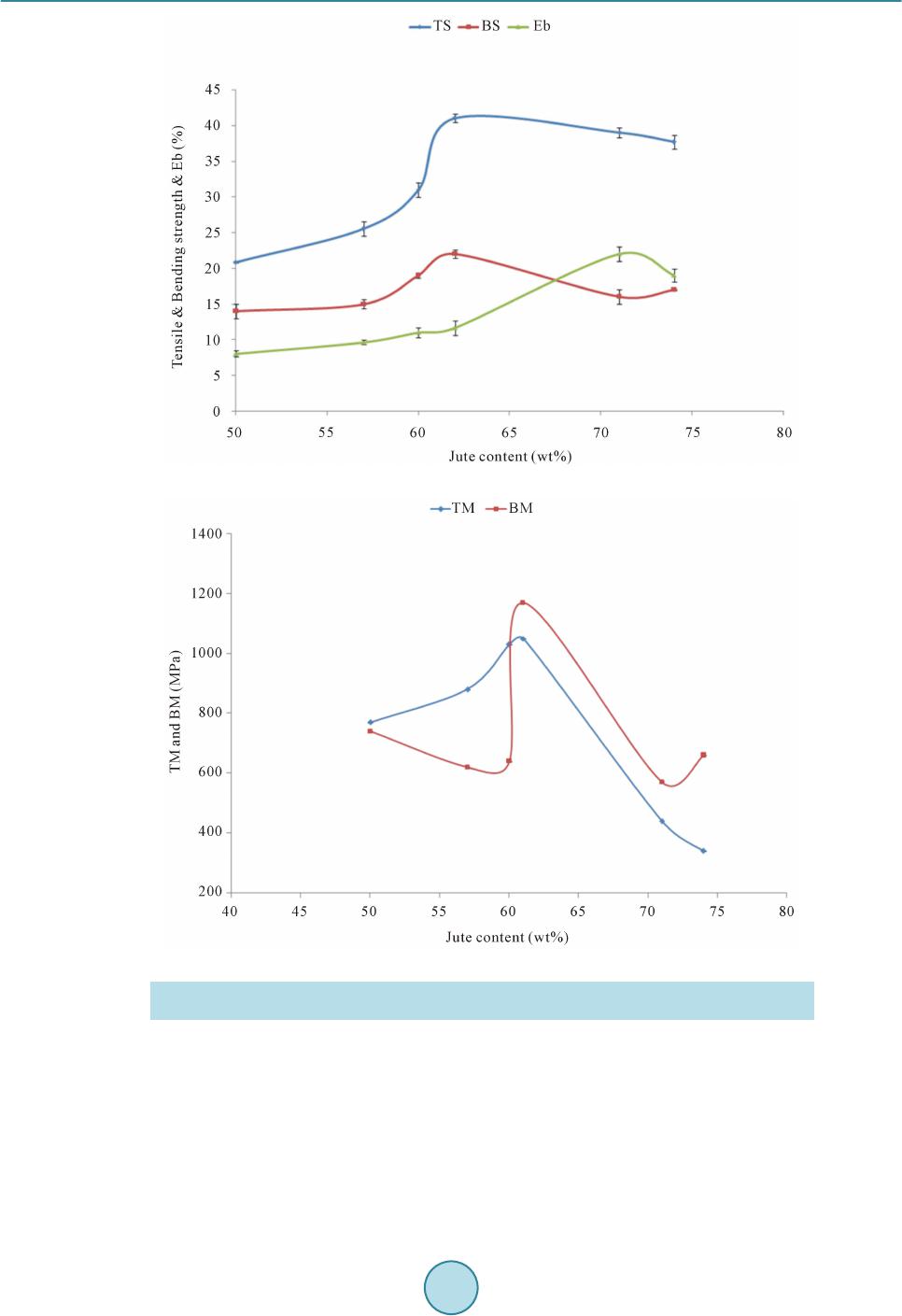 L. R. Das et al. (a) (b) Figure 4 . (a) Effect of jute content (wt %) on the strength of untreated jute-based composites; (b) Effect of jute content (wt %) on the modulus of untreated jute-bas ed composite. different soaking times are presented in Figure 5. It has been observed that TS is higher for 0.1% AC extract and for 2 min soaking time. But TS of hessian cloth decrease with the increase of soaking time and concentra- tion of AC extracts. T he highest TS (24 MPa) was for 0.1% AC extract and for 2 min soaking time. T he TS is 115% higher compared to untreated hessian cloth. For 0.5% solution of AC extract the TS increased up to 10 min soaking time and then gradually decrease. The maximum TM is 368 MPa for 1% AC extract. M. Naznin et.al found that Polyphenolic compound of AC extract fit into the changes in tensile properties of Starch/PVA Film and establish hydrogen bonding with OH groups of St/PVA [16]. So there may be a hydrogen bonding with 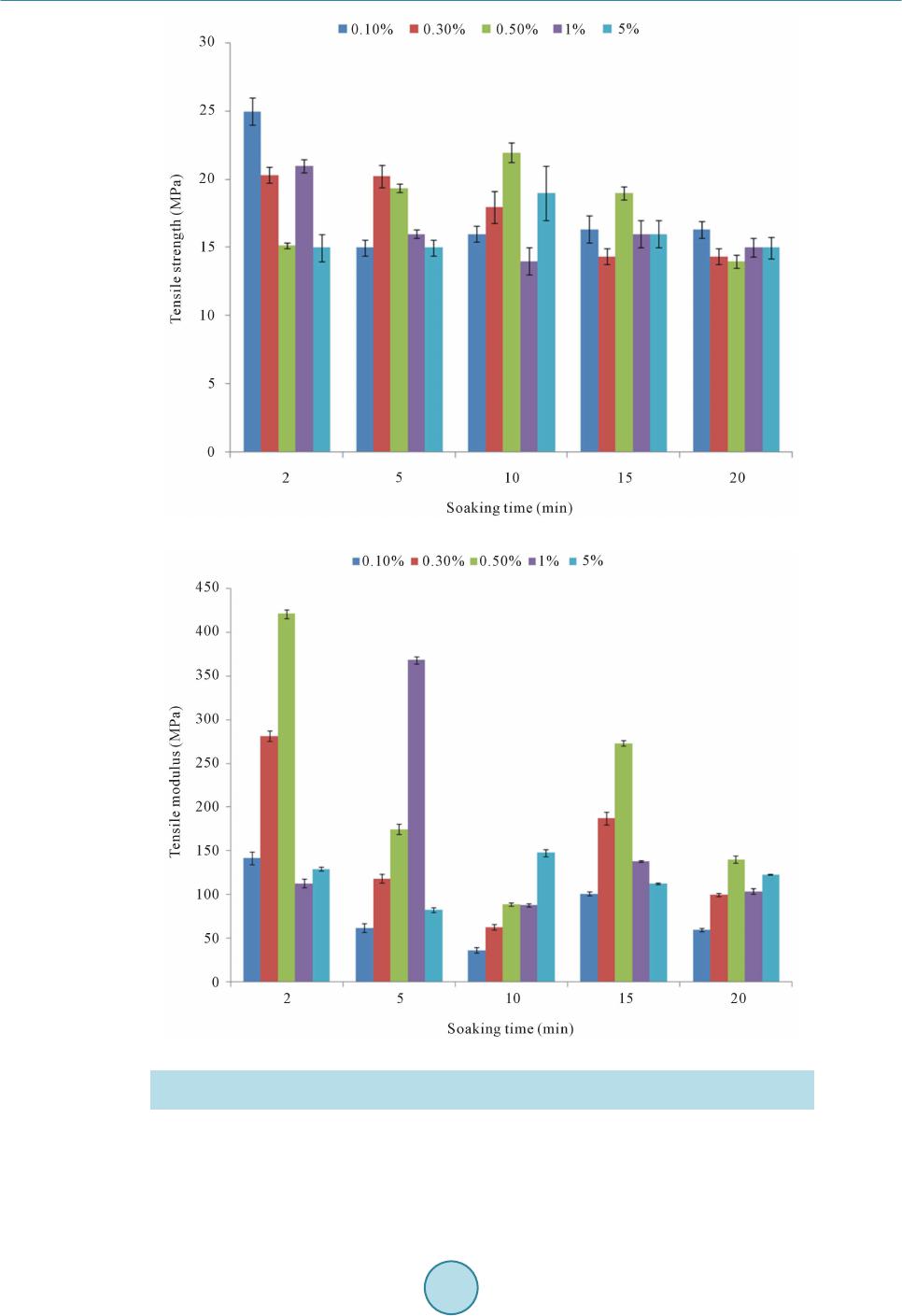 L. R. Das et al. (a) (b) Figure 5 . (a) Effect of AC on Tensile strength of jute fabric; (b) Effect of AC on modulus of jute fab r i c . OH group of Jute fabrics. Changes in mechanical properties as affected by polyphenolic compounds were also observed for other biopolymeric films [17] [18]. However, after a certain value with the increase of soaking time the TS and TM of the hes sia n clo t h gr ad ua ll y  L. R. Das et al. decreased (Figure 5(a) and Figure 5(b)). This sharp decrease of TS and TM at higher soaking time may be due to shrinking of compactness of the jute fabrics components. The mechanical properties of the treated hessian cloth based composites were found to be higher than those of the untreated hessian cloth based composites. Among all the formulations 0 .1% AC treated hessian cloth based composite s howed the highe st tensile stre ngth (Table 1 ). I t was fo und t hat the maximu m T S, BS, TM, BM of jute/hybrid polymer composite were found to be 47 MPa, 39 MPa, 1220 MPa, 1784 MPa for 0.1% AC solution and for 2 min soaking time. It has been seen that AC extract treated jute-based composite TS and BS is 9% and 70% higher than that of untreated composite. At higher AC extract concentration the Jute fabrics become too sticky and as a result the adhesion between the fi- bers and matrix may not be so good. Probably this is the cause of low TS and BS of the AC extract treated composite as found in the experiment. The TM, BM also followed the same trend. 3.6. Frequency Dependence Electrical Properties of the Composite Dielectric constant decrease with increasing frequency, so frequency has an important influence on dielectric properties. This was because at high frequencies, the rotation motion of the polar molecules of dielectric is not sufficiently rapid for attain of equilibrium with the field [19]. Figure 6(a) shows the variation of dielectric properties with frequency from 8 KHz to 500 KHz at room temperature. It has been observed that the dielectric constant decreased from 8 KHz to 250 KHz for untreated sample and 8 KHz to 200 KHz for treated sample with increasing frequency for all the specimens exhibiting a normal dielectric behavior of materials, which may be due to the interfacial polarization as predicted by Maxwell and Wagner [20]. The dielectric constant of poly- meric material depends on interfacial, dipole, electronic and atomic polarization [21]. The dielectric constant af- ter decreasing reached a constant value and finally become almost constant. It was found that all the samples have higher dielectric constant at low frequency. The highest dielectric constant for 8 KHz is 8.98 for untreated sample and 20.08 for treated sa mple. This high value of dielectric constant at lower freq uency re gion is due to the Maxwell-Wagner interfacial type of polarization [20] for the inhomogeneous double layer dielectric struc- ture, whic h i s i n a gr eement wi th K oo p s p he no me no l ogi ca l t he o r y [22]. The d ipo les li me up in the field d irectio n at lo w frequenc y but at high frequencies when the field is in reverse directio n they take reverse direction. T his was because at high frequencies, the rotational motion of the polar molecules of dielectric is not sufficiently rapid for attain of equilibriu m with the field [19]. O wing to their i nertia, the dipole s took a certain ti me to be in reverse direction, this is called as relaxation time. When the frequency is high the dipole will follow the changes of the field and the dielectric constant will decrease. In Figure 6(b) we found the variation of dielectric loss factor from 8 KHz to 150 KHz for untreated sample and from 8 KHz to 200 KHz for treated sample. In the re- verse direction of field the internal friction of the dipoles are so high that the dielectric loss factor decrease. The dielectric Loss factor varied from 8 KHz to 250 KHz and become almos t c onstant (Figure 6(b)). 3.7. Water Uptake Water uptakes of untreated and treated hybrid composite were measured by soaking the samples in a glass beak- er containing static water at room temperature (25˚C) for 70 min. The percent of water uptake of the control and AC treated jute fabrics-(PET+LLDPE) composite was measured with different time intervals (min). The results were presented in Figure 7. It is observed that water absorption of control composite is higher than that of AC treated jute composites. In treated composite, the better fiber-matrix a dhesio n mi ght b e resp ons ib le for t he lower tendency of water uptake compared to control composite. It is also mentionable that at the beginning water ab- sorption for both untreated and treated composite is very rapid because they played as osmotic behavior. After 30 minutes of water soaking, percent of water gain of control composite become lower. This phenomenon is also observed for AC treated composite. At static condition, fibers get saturated with water molecules and can no more gain water from the surroundings and finally decreased because they played as reverse osmotic behavior. 3.8. Degradation in Soil Both untreated and AC extract treated composite samples were immersed in soil for about 30 days. The loss of TS was periodically measured and the results are presented in Figure 8 wit h respect to degradation time. The loss of TS of untreated was higher than that of treated sample. It was observed that the TS loss increased with increasing degradation time (days). 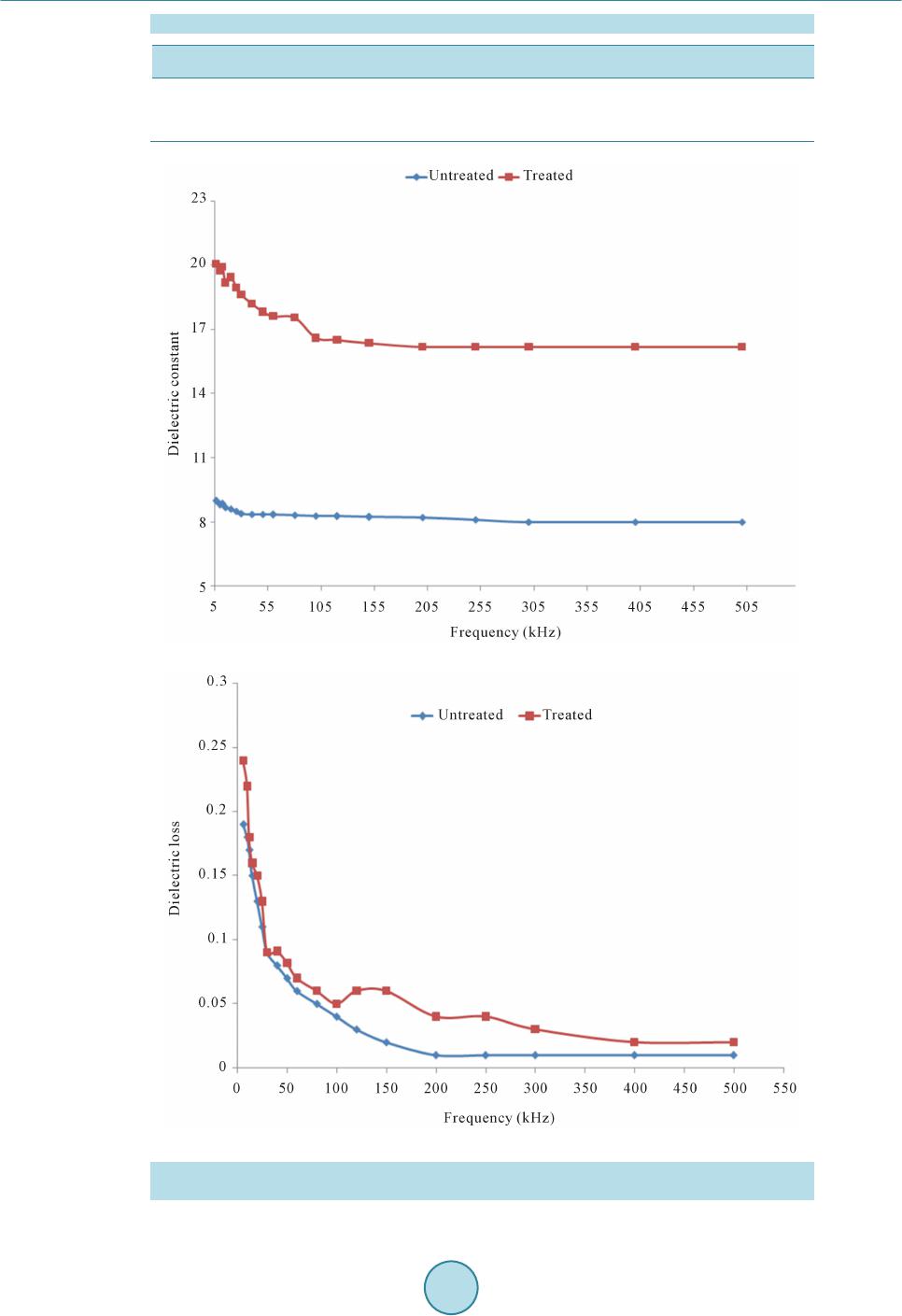 L. R. Das et al. Table 1. Optimized condition of 0.1% AC treated composite. Optimized condition Mechanical proper t i es - TS MPa Eb% TM MPa BS MPa BM MPa 0.1% AC treated composite 47 25 1220 39 1784 (a) (b) Figure 6. (a) Variation of dielectric constant with frequency for untreated and AC treated com- posite; (b) Variation of dielectric loss with frequency for untreated and treated composites. 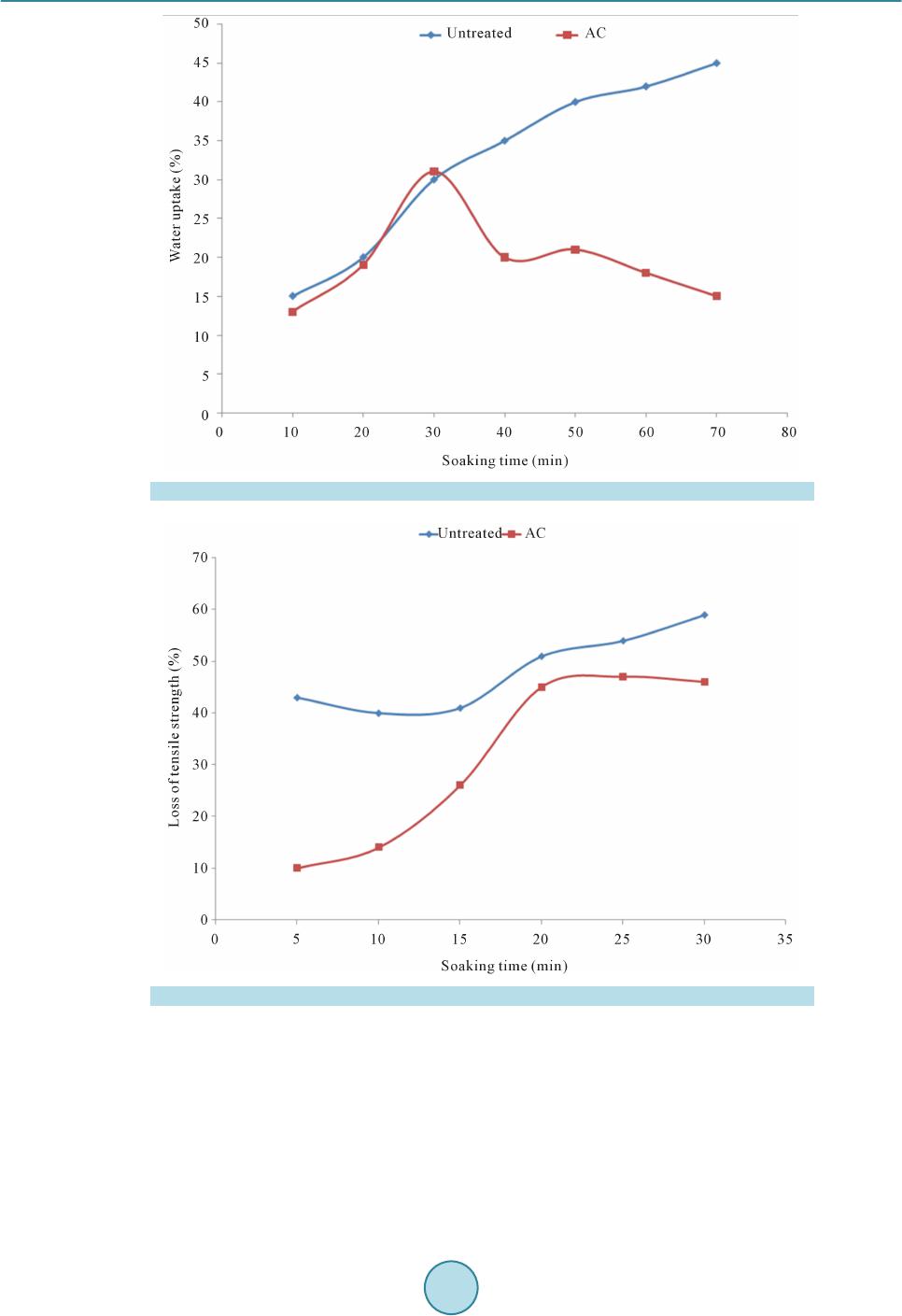 L. R. Das et al. Figure 7 . Water uptake o f u ntreated an d treated composites against soaking time. Figure 8 . Los s of tensile strength agains t degradation t ime because of soil degradat ion. 4. Conclusion Inve sti ga ti on s ho wed that the mechanical properties of jute fabrics reinforced pol ymer composite showed a good result. Jute fabrics were treated with AC extracts in order to improve mechanical properties. The highest TS for 0.1% AC treated jute fabrics were 24 MPa which was increased about 115% compared to untreated jute fabric. Again jute/hybrid matrix composites were prepared with 0.1% AC treated jute fabric. The highest TS, BS were 47, 39 MPa, and TM, BM were 1220 and 1784 MPa respectively which were increased about 9%, 70%, 16% and 52% respectively. The FT-IR analysis showed that there ocurred no chemical reaction bet ween AC and jute  L. R. Das et al. fiber . Fr o m T GA a na l ysi s, it was found that AC treated jute fabric was more thermally stable than untreated jute fabric. Water uptake behavior of the treated sample showed a lower trend compared to untreated sample. The dielectric constant and dielectric loss factor both decrease with increasing frequency. The dielectric constant and dielectric lo ss factor are b oth higher for treated composite. It can be concluded that with efficient and continual research there will be good possibility and better future for polymer reinforced composites for suitable electrical applications such as terminals, connectors, switches, circuit boards etc. References [1] Shibata, M., Takachi yo, K., Ozawa, K., Yosomiya, R. and Takeshi, H. (2002) Biodegradable Polyester Composites Reinforced with Short Abaca Fiber. Journal of Applied Polymer Science, 85, 129-138. http://dx.doi.org/10.1002/app.10665 [2] Mizanur, R.M., Malik, A.K. and Khan, M.A. (2007) Influences of Various Surface Pretreatments on the Mechanical and Degradable Properties of Photografted Oil Palm Fibers. Journal of Applied Polymer Science, 105, 3077-3086. http://dx.doi.org/10.1002/app.26481 [3] Reddy, N. and Yang, Y. (2006) Properties of High-Quality Long Natural Cellulose Fibers from Rice Straw. Journal of Agricultural and Food Chemistry, 54, 8077-8081. http://dx.doi.org/10.1021/jf0617723 [4] Mwaikambo, L.Y. and Ansell, M.P. (2002) Chemical Modification of Hemp, Sisal, Jute, an d Kapok F ibers by Alkal i- zation. Journal of Applied Polymer Science, 84, 2222-2234. http://dx.doi.org/10.1002/app.10460 [5] Khan, M. A., Hassan, M.M. and Drzal, L.T. (2005) Effec t o f 2 -Hyd rixyethyl Met hacryl ate (HEM A) on the Mech anical and Thermal Properties of Jute/Pol y ca rbona t e C om pos ite s . Compos ite A : Applied Sc ie nce and M anufactur i ng, 36, 71-81. [6] Bogoeva-Gaceva, G., Avella, M., Malinconico, M., Buzarovska, A., Grozdanov, A., Gentile, G. and Errico, M.E. (2007) Natural Fib er Eco-Composites. Polymer Composites, 28, 98-107. http://dx.doi.org/10.1002/pc.20270 [7] Hye , M.A., Taher, M.A., Ali, M.Y., Ali, M.U. and Shahed, Z. (2009) Isolation of (+)-Catechin from Acacia catechu (Cutch Tree) by a Convenient Method. Journal of Scientific Research, 1, 300-305. http://banglajol.info/index.php/JSR/article/viewArticle/1635 [8] Zhang, H., Zhang, Y., Guo, W. and Wu , C. (2008) Thermal Properties and Morphology of Rec ycled Pol y(ethylene te- rephthalate)/Maleic Anh ydrid e Grafted Lin ear Lo w-Density Polyethylene Blends. Journal of Applied Polymer Science, 109, 3546-3553. http://dx.doi.org/10.1002/app.28456 [9] Kagan, V.A., Palley, I. and Jia, N. (2004) Plastics Part Design: Low Cycle Fatigue Strength of Glass-Fiber-Reinforced Polyethylene Terep hthalate (PET). Journal of R e inforc e d Plas ti c s and Composi te s , 23, 1607-1614. http://dx.doi.org/10.1177/0731684404039784 [10] Rebeiz, K.S. and Fowler, D .W. (1994) Flexur al Proper ties o f Rein forced Polyester Co n crete M ade wi th Recycled P E T. Journal of Reinforced Plastics and Composites, 13, 895-907. http://dx.doi.org/10.1177/073168449401301004 [11] Hasan, M.M., Islam, M.R. and Khan, M.A. (2003) Improvement of Physico-Mechanical Properties of Jute Yarn by Photografting with 3-(Trimethoxysilyl) Propylmethacrylate. Journal of Adhesion Science and Technology, 17, 737-750. http://dx.doi.org/10.1163/156856103321340840 [12] Silverstein, R.M., Bassler, G.C. and Morrill, T.C. (1981) Spectrometric Identific Action of Organic Compounds. 4th Edition, John Wiley and Sons, New York. [13] Menczel, J.D., Ju dovits , L., Prime, R.B., Bair, H.E., Readin, M . and Swier, S. (2009) Differential Scanning Calorime- try(DSC). In: Menczel, J.D. and P ri me, R.B., Eds., Thermal Analysis of Polymers. Fundamentals and Applications, Wiley, San Jose, 7-239. [14] Ball, R., Melntosh, A. and Brindley, J. (2004) F eedback Processes in Cellulose Thermal Deco mposi tion: Implicatio ns for Fire-Retarding Strategi es and Treatmen ts. Combustion Theory and Modeling, 8, 281-291. http://dx.doi.org/10.1088/1364-7830/8/2/005 [15] Connor, M., Bidaux, J.E. and Manson, J.A.E. (1997) A Criterion for Optimum Adhesion Applied to Fibre Reinforced Composites. J our n al of Material Sci e nc e , 32, 5059-5067. [16] Naznin, M., Abedin, M.Z., Khan, M.A. and Gafur, M.A. (2012) International Scholarly Research Network. ISRN Po- lymer Science, 2012, Article ID: 348685. [17] Gome z-Estu ca, J., Gimenz, B., Mentro, P. and Gomez-Guillen, M.C. (2009) Incorporation of Antioxidant Borage Ex- tract into Edible Films Based on Sole Skin Gelatin or a Commercial Fish Gelatin. Journal of Food Engineering, 92, 78- 85. http://dx.doi.org/10.1016/j.jfoodeng.2008.10.024 [18] Gome z-Guillein, M.C., Ih l, M ., Bifani, V., Silva, A. and Montero, P. (2007) Edible Films Made from Tuna-Fish Gel a- tin with Antioxidant Extracts of Two Different Mu rt a Ecotypes Lea ves (Ugni molinae Turcz). Food Hydrocolloids, 21, 1133-1143. http://dx.doi.org/10.1016/j.foodhyd.2006.08.006  L. R. Das et al. [19] Smyth, C . (1956) Dielectric Behavior and Structure, McGraw Hill, Oxford, 53. [20] Wagner, K.W. (1913) Zur Theorie der Unvollkommenen Dielekrika. Ann ale n de r Phy si k , 345, 817-855. http://dx.doi.org/10.1002/andp.19133450502 [21] Jayamoland, G., Bhagwan, S.S. and Thomas, S. (1997) Electrical P roperties of Pineapple Fibre Reinforced Polyethy- lene Composites. Journal of Polymer Engineering, 17, 383-404. [22] Koops, C.G. (1951) On the Dispersion of Resistivity and Dielectric Constant of some Semiconductor at Audio Fre- quencies. Physical Review, 83, 121-124. http://dx.doi.org/10.1103/PhysRev.83.121
|